How To Set Up A Financial Plan
Executive Summary
It is a uncomplicated question: how much does it cost to get a comprehensive financial programme? Yet despite the rising popularity of financial advisors offering financial planning services, remarkably little has really been published about what fiscal advisors charge for the service. Which is striking for both consumers – who desire to know what a plan might cost – and for financial advisors themselves, who may desire to criterion whether the pricing for their financial plans is "reasonable" relative to their advisor peers and competitors (rather than solely setting the price based on its time-and-labor cost to the advisor).
In our latest Kitces Research survey on "What Financial Advisors Actually Exercise", we found that the average cost for a standalone comprehensive fiscal plan is $2,400 (up from $ii,200 in a 2022 study from the Financial Planning Association). Notably, though, our research finds that more and more advisory firms who offer financial plans actually are charging for them separately – rather than merely bundling the plan into their AUM fees – and in fact there is a growing rise of financial advisors who are charging for financial plans solely in a "fee-for-service" manner (hourly fees, monthly subscription fees, or annual retainer fees), rather than blending fees with AUM at all.
In addition, not surprisingly, financial plan fees did vary significantly from ane firm to the next, although as information technology turns out, the biggest driver of financial planning fees is not the cost (i.e., how long it takes) to produce the plan, nor even how comprehensive the programme is, but the affluence of the customer themselves paying for the plan in the first identify. In other words, clients with more than fiscal means to pay for a financial plan tend to pay more for a financial plan. Opening a contend of whether more flush clients pay more than for fiscal plans simply because they can beget to do so, because they tend to use more experienced advisors with deeper expertise (fifty-fifty if "the plan" itself is the same), or merely considering their college net worth and affluence means they perceive more value in the financial program, to begin with.
On the other hand, information technology's notable that, considering financial advisors just spend nearly 50% of their time on customer-facing activities in the offset identify, advisors are notwithstanding greatly limited by how many financial plans they tin do and how many clients they can back up, which ultimately limits their power to charge for their time and generate revenue. In the end, the average counselor generates a fee of about $150/hr for their client-facing activities… even as they only spend about 50% of their fourth dimension on client activities that generate fees in the starting time identify.
On the other hand, the research does signal that advisors who have avant-garde professional designations, and more than years of experience, do manage to command higher financial planning fees in the market place. Though, again, this appears to be less a function of advisors with greater credentials and experience charging higher fees, per se, and more the result of experienced and credentialed advisors being more constructive at alluring the more than flush clients who are willing to pay college fees and perceive greater value in the financial plan in the start identify. Which means in the end, when information technology comes to setting the cost and determining value, the answer to "what should a financial plan price" truly is in the optics of the beholder.
How Much Does A Fiscal Plan Cost?
How much does a financial plan toll? It seems like a relatively straightforward question to answer. In fact, some of you might already be thinking, "Like shooting fish in a barrel, a financial plan ordinarily costs 1% of avails under management," (which is probably not quite the whole truth). But yes, to that point, it is well established that the industry has retained and continues to retain its ongoing love affair with AUM-based pricing. Nonetheless, this "reply" or this "industry standard" does not honestly or exactingly answer this "simple" question.
Historical Data On How Much A Financial Plan Costs
The leading historical written report answering the question "how much does a fiscal plan toll" was a "Fiscal Plan Development and Fees" written report produced in 2022 by the Financial Planning Association (FPA) and its Research And Exercise Institute, which surveyed 527 of its financial counselor members on the fiscal planning fees they charge their clients.
The FPA Planning Fees study found that, for advisors who charge a apartment fee for a comprehensive plan, the median fee charged was $ii,250. Advisors who charged an hourly fee had a median of $193/hour, and those who charged servant fees had a median cost of $two,450/year.
Notably (though non surprisingly), the FPA study institute that fees charged appeared to be direct related to the depth of the plan for clients, every bit comprehensive plans had a median toll of $two,250, while more modular financial plans had a median fee of only $850. Fourth dimension spent working on a financial plan too mattered. The more time the plan took to develop, the more expensive the program was, and the average advisor reported having spent eleven.9 hours on a single financial plan.
Withal, the FPA written report also noted charging "merely a fee" for a financial plan was rather rare, stating that "Assets under direction (AUM) fees still reign supreme, with nearly twice as many advisors reporting that their practices utilise an AUM fee to generate acquirement compared with any other revenue method." Still, though, AUM-centric didn't mean AUM was the merely fee model at play when charging for fiscal advice. In fact, the FPA report found 82% of advisors reported using an AUM fee, but virtually of those also had some kind of hourly, flat, or retainer-based financial planning fee construction as well (either separately, or on top of their AUM fee).
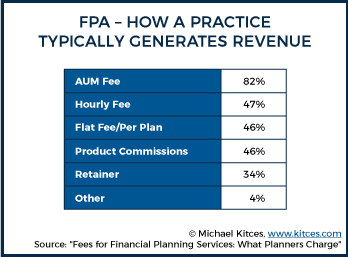
A more recent 2022 study on the fees that advisors charge, by Bob Veres, included 956 advisors at RIAs and broker-dealers and similarly found that while the AUM model remains dominant (even amid those who deliver financial planning and not "simply" investment management), the trend in overlapping fees has continued. Specifically, Veres found that more than than one-half of financial advisors doing fiscal planning (nearly 55%) were charging an AUM fee likewise every bit a separate financial planning fee, and that charging but AUM fees is really only washed by a minority of advisors.
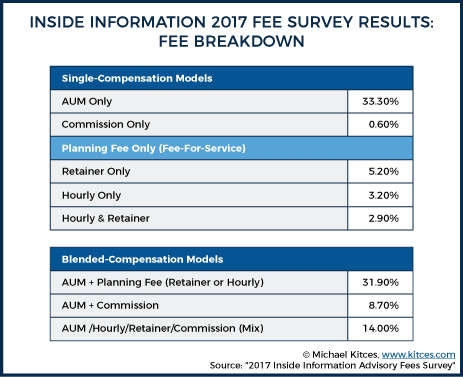
And in turn, the fact that nigh 1/third of firms stated that they did financial planning while charging only an AUM fee did non cease them from assertive that a portion of the AUM fee was actually "the planning fee." In fact, when Veres asked just that, "When you accuse an AUM fee, what percentage of it should properly be allocated to managing avails vs. non-asset management similar financial planning?" the results were clear in that advisors, even those charging just AUM, saw the fee in parts (i.e., the one AUM fee was for both investment management and financial planning). Notably, though, while advisors almost unanimously showed that they believe the planning piece of work deserved some kind of fee associated with it (or allocation of the AUM fee towards information technology), there was no clear consensus on what percent of the AUM fee covered financial planning.
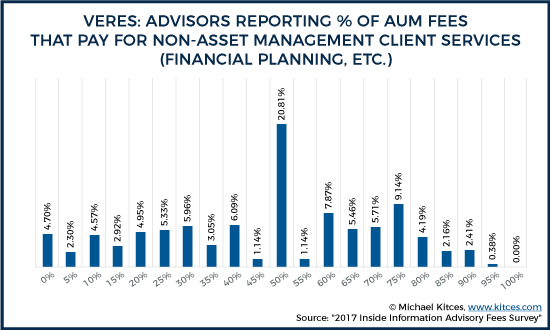
Nonetheless, Veres did endeavour to calculate, using information from the AUM-only advisors, how advisors were divvying up the nugget direction fees versus the planning fee for a wide range of portfolios, having nerveless AUM fees based on portfolio size, and the percentage of the fee that each counselor typically counted toward asset management versus planning services seen below in the Inside Information 2022 Fee Survey Results chart.
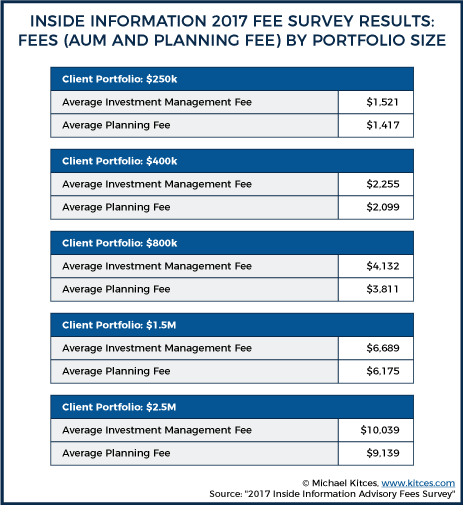
Interestingly, though, i trend that sticks out from both the FPA and Veres studies was that at that place was remarkably fiddling variation in advisory fees past the feel level of the advisor themselves. Neither study found whatever textile difference in the (dominant-model) AUM fees charged by less experienced advisors versus more experienced advisors. This may simply be because advisors, new or old, have the same fee schedule, but more than experienced advisors will manage to attract more affluent clients (who so pay higher fees just because their accounts and therefore AUM fees are larger, fifty-fifty though the AUM fee schedule itself is the same). On the other hand, outside of AUM fee trends, the FPA study did find that standalone planning fees tend to be higher for more experienced advisors when looking at modular plans – advisors with less than five years of experience charged $550, while advisors with 20+ years charged $ane,000.
The Latest Kitces Research On How Much A Financial Plan Really Costs
Given that the FPA study on Financial Planning Fees is now more than than half dozen years erstwhile, and the more recent Veres study did not specifically clarify financial planning fees in particular, Kitces Research decided in 2022 to bear its ain study on what fiscal planners actually accuse for their financial planning services.
The results, based on the pb and associate advisors from a sample of more than than i,000 financial planners, found that the ongoing rise of fiscal planning (versus just investment management) is slowly simply steadily causing a split up in the counselor community, where fewer advisors are charging blended fees, and more than and more advisors are either all-in on the AUM model or all-in on some standalone fee-for-service model.
Specifically, the Kitces Research report found that the percent of fiscal planners charging "simply" AUM fees is up to 43.ii%, but the percentage charging "just" on a fee-for-service basis (e.g., standalone fee, retainer fee, or hourly), is upward to 27.8% (as compared to only 11.three% in Veres' study). In turn, simply 26.9% of advisors were charging some sort of blended fee model (AUM, Commissions, and fees), down from 54.6% in the Veres study.
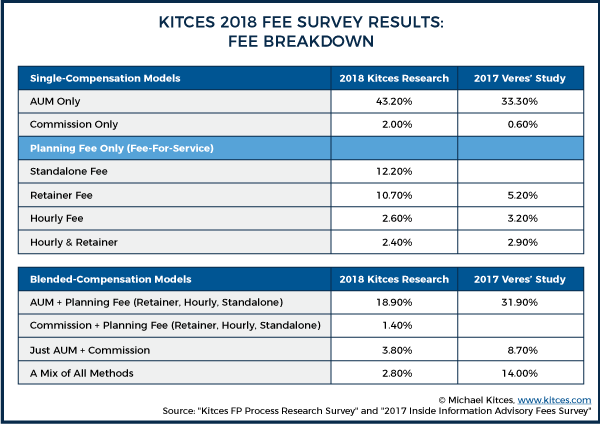
What Do Advisors Charge for Merely A Financial Plan?
With the ascension of more fiscal planners charging standalone planning fees in various fee-for-service models (too as those who accuse split up planning fees on top of AUM fees), our Kitces Research report was able to collect some of the near robust information ever collected on what financial planners actually charge for their financial planning services.
Notably, though, the average toll of a financial plan for (just) a fee, even amongst the advisors charging solely under a fee-for-service model, varied depending on which type of fee structure was beingness used in the offset identify.
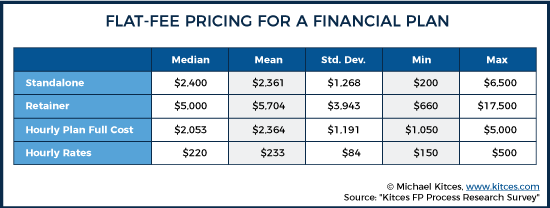
However, when comparing and contrasting those advisors who charged for financial planning using a planning-fee-Simply model, versus those that used a blended planning-fee-PLUS (plus AUM or commissions) model, some interesting trends emerged.
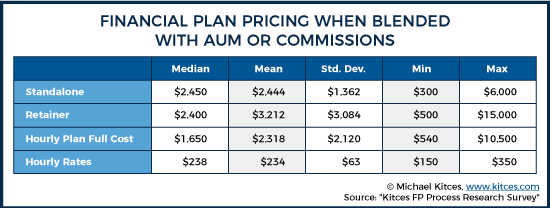
First, for those advisors who reported charging a standalone fee for a financial plan – it did non seem to matter if they charged "just the fee" or if they charged an AUM plus a divide planning fee, the fees were relatively similar (with a median correct around $2,400). In other words, when advisors charge for a financial programme, they appear to be fairly consistent in charging for that programme; the AUM fees, if separately charged for implementation, appear to be positioned as a divide service (as opposed to discounting financial planning fees and then trying to "brand them up" on subsequent AUM fees when assets are gathered).
The same trend can exist said of hourly. Hourly planners do not announced to be increasing or decreasing fees in recognition of the potential for subsequent AUM fees. The typical hourly fee for advisors who charged only planning fees was $220 ($233 boilerplate), while those who charged hourly fees and for subsequent AUM fees had a typical hourly fee of $238 ($234 average). Moreover, when advisors work via "projects" (e.g., a bundled set of hourly fees to construct a total programme), the sometimes-additional AUM fee that they may also receive however does not impact or discount the toll of the financial plan.
When it comes to ongoing planning fee models, though – i.eastward., advisors who charge ongoing retainer fees for an ongoing financial planning human relationship rather than "just" a ane-time standalone planning fee for a one-time planning appointment – a different design emerges. Considering a retainer fee is an ongoing relationship-based model – as opposed to hourly or standalone planning fees, which are more transactional – when AUM fees are removed from the picture, retainer fees must conduct the total weight of supporting the ongoing holistic advice relationship. Accordingly, advisors charging but retainer fees had a median fee of $5,000/year, compared to less than half that amount ($2,400/year) for those also charging AUM fees.
How Financial Advisors Are Setting Fees…
The standard manner to set up pricing for a service is to figure out its cost, add an allowance for a profit margin, and price accordingly. And given that financial planning is a time-intensive service, ane would naturally expect that the cost of a financial plan would exist tied to the time it takes to produce the plan (as was shown in the earlier 2022 FPA study).
However, based on our Kitces Research data, the design is non then cut and dry. In fact, there were no statistically significant relationships betwixt the total time to produce a financial plan and its cost when aggregated across all the advisor business concern models.
A deeper dive, though, reveals that the lack of whatever relationship between the time to produce a plan, and its cost, on average, may itself be a function of blending together the unlike fee structures. When examined separately, fee-only models showed a fairly strong positive relationship between total fourth dimension and client face-fourth dimension and the planning fee, simply a negative relationship to actual plan constructive time and the fee. Whereas fee+AUM models showed similar trends (positive relationship between full and client-facing time and costs, but negative relationship between program construction time and plan costs), but the relationship was non quite every bit pronounced. Which isn't entirely surprising, either; those engaged in fee-only planning have more than of a business incentive to really pay attention to the profitability of plans (fees charged relative to time spent), when information technology is their sole source of revenue as an informational firm.
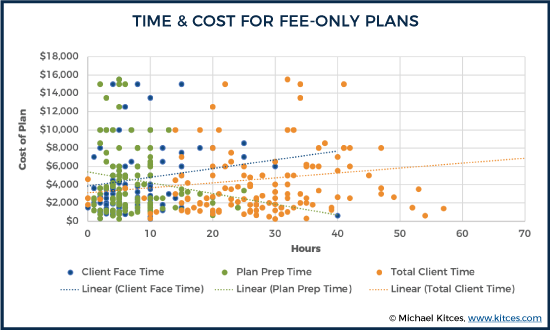
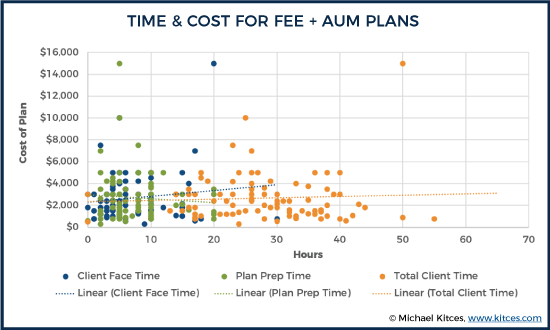
Similarly, there were no statistically significant differences between the comprehensiveness of the programme and its fee… except for when it came to fee-only retainer plans. As in the Kitces Research survey, advisors were asked to identify, from a list, what topics they included in their financial plans, and this listing was so used to create four categories that described the plans based on the number of topics/items/services within the plan. The category of "Most Comprehensive"was given to plans with 13+ items, 10-12 item plans were referred to as "Comprehensive", 6-9 detail plans were labeled as "Planning Calorie-free", and "Targeted plans" covered 5 or fewer areas. And as shown below, targeted plans were not surprisingly the to the lowest degree expensive across the lath.
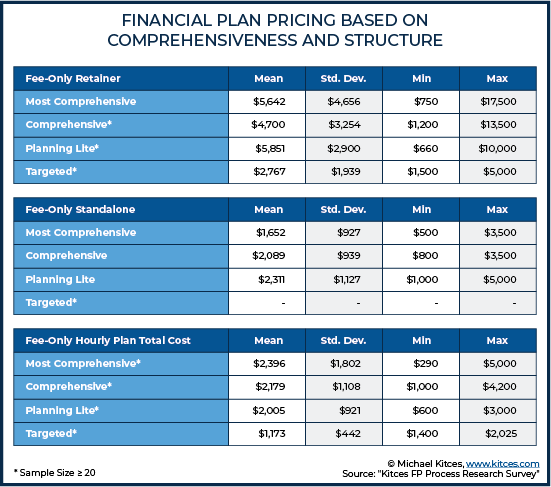
However, outside of targeted plans, all plans, regardless of comprehensiveness, hover around the same pricing! Retainers are effectually $5,000, Standalones are effectually $two,000, and the full cost of an Hourly Programme also runs around $2,000. In other words, the about comprehensive plans were non priced significantly higher than relatively "lite" plans covering just a handful of planning modules.
Though notably, the lack of any difference may be a testament to the efficiency of planning software – that even equally advisors add more breadth to a program, it doesn't take a lot more time.
The primal point, though, is that there is remarkably little direct relationship between what financial planners charge, and the time (and implicit fourth dimension-based cost) to produce it. Instead, the results propose that advisors are still most heavily focused on charging for financial planning by literally charging for "the plan" itself (i.e., the physical plan deliverable). Which can even create mismatches in pricing, every bit it inevitably suggests there may be a number of financial planners who are not charging enough (i.due east., charging above-average fees for an above-boilerplate time cost to create the plan in the first place).
Value-Based Pricing Of Financial Planning
On the other hand, information technology turns out that advisors do at least appoint in some level of value-based pricing. Or at least, adapt the depth and scope of their plans (and pricing) to the level of clientele they serve (and what those clients can afford in the first place).
Specifically, our Kitces Inquiry report found that, beyond the board, the more affluent the client (whether measured by income, investable assets, or net worth), the higher the fees planners tend to accuse them for a fiscal plan (particularly when it comes to standalone or retainer fees).
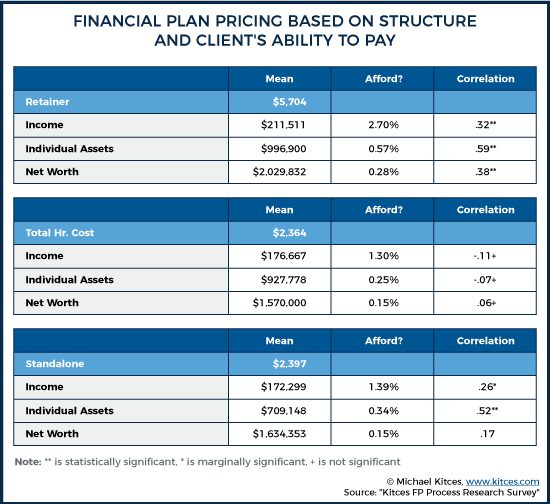
In essence, the data suggests that the fees charged transactionally for a standalone financial plan (or more than directly, the fees that clients are willing to pay for a financial plan) amount to roughly 1.3-1.four% of their income and/or 0.15% of their net worth (when looking at standalone and full-hourly scenarios). While a more holistic ongoing planning relationship – for an ongoing retainer fee – averages virtually two.7% of income or 0.iii% of net worth. Overall, though, even in fee-for-service models, the necktie back to investable assets is remarkably inescapable – as investable assets were still the all-time predictor of fees, fifty-fifty for advisors not charging an AUM fee! Which suggests that even clients who engage fee-for-service financial advisors are still comparing those retainer or standalone planning fees to what an AUM-based advisor would charge… such that the most acceptable "not-AUM" fee is still the ane that is comparable to what an AUM-fee advisor would have charged.
On the other manus, hourly fees (and the cumulative hourly fees incurred for an hourly advisor's typical engagement) had no predictive relationship to income, assets, or net worth, suggesting that the hourly model truly is a more flexible model that serves a wider range of clients (while retainers and standalone comprehensive planning fees calibration more direct with the client'due south financial ability to purchase them).
The key point, though, is that financial planning fees, in general, appear to take more of a relationship to the income and internet worth (i.e., their client's affluence) and especially the investable assets of the client themselves, rather than the comprehensiveness of plan or the fourth dimension information technology takes to produce. Or stated more directly, clients pay for financial planning based on what they tin afford (and ostensibly, the value they perceive relative to their affluence), rather than the fourth dimension or other costs of the service being provided. Which is important, as information technology suggests that advisors who can reach more flush clients will have improve pricing and margins for a similar service, helping to explain why information technology is that most financial advisors tend to institute minimums and motion "upmarket" towards more flush clients as they proceeds more experience and their practices mature.
More by and large, these results too suggest that the better way for financial planners to price their services (or at least, what works ameliorate in practice) is to improve show how the plan relates to the value the client receives relative to their own income and net worth, and not attempt to justify fees based on how much time/endeavor it costs the advisor to produce the advice in the beginning place. Though at the aforementioned fourth dimension, these results also suggest that, especially amid more than affluent clients, there may exist more than opportunity for fee and pricing disruption, given that the connexion between an counselor'south financial planning fee and the toll to produce that plan is then "tenuous" in the first identify!
Other Factors That Impact Fiscal Plan Pricing
When it comes to other factors that may affect the pricing of a fiscal plan, another not-surprising key cistron is the touch of professional person didactics itself. Every bit the FPA's study in 2022, along with the electric current Kitces research study, found that certification, of many types, matters. Advisors with no certification charge less than those advisors with some sort of professional person certification.
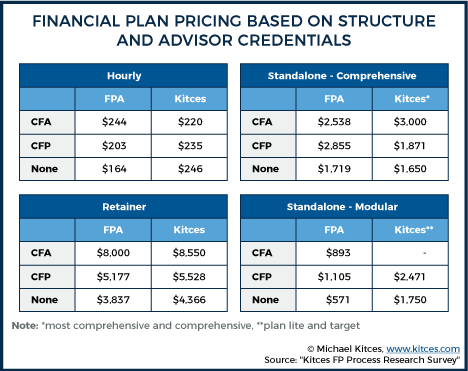
Yet, given the earlier results that financial planning fees themselves are more directly correlated to the affluence of the client than the comprehensiveness of the program (or at least, the fourth dimension to produce the more comprehensive plan), these results imply that the benefit of a certification may non be the ability to get paid more for a comprehensive plan, per se, but instead the ability to meliorate get in front end of more flush clients who are willing to pay more for planning communication in the first place. In other words, professional person certification doesn't necessarily allow advisors to accuse more for their plans, but it does appear to get them access to more flush clients who tin pay more (whether past having more than conviction as a financial planner, or more credibility due to the certification itself?).
On the other hand, our Kitces Research results suggest that in that location is notwithstanding some premium associated with the depth of a financial plan – or at least, that some types of planning software are better positioned to produce financial plans to those more affluent clientele who, in plough, are willing to pay more than for the outcome.
Specifically, in servant situations, advisors who use more cash-period-based fiscal planning software (e.one thousand., eMoney Counselor, NaviPlan, and MoneyTree) command higher financial planning fees than those who use goals-based software (e.g., MoneyGuidePro, Advizr, and RightCapital). Though the exact opposite is true for standalone and hourly planning fees (where clients pay more on a standalone basis for a goals-based financial plan output than a cash-flow-based plan).
Thus, to the extent that plan preparation time was related to financial planning fees, information technology appears that the time it takes to use more than comprehensive financial planning software to produce a more in-depth plan is rewarded in the marketplace by clients, at least when a long-term or ongoing relationship has been established. Thus, while the average fourth dimension to set a plan in cash-menstruum-based planning software was 8.0 hours, compared to just seven.2 hours for goals-based planning software, servant advisors were rewarded for this (slight) actress time.
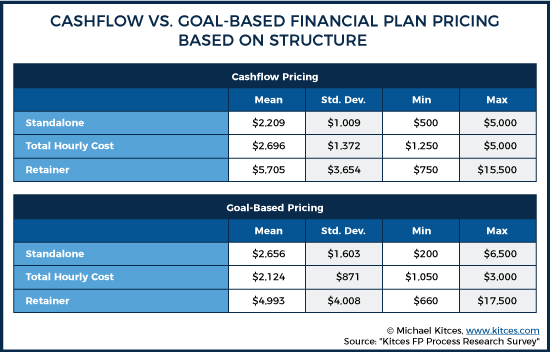
What is A Financial Advisors Time Actually Worth?
Ane of the fundamental challenges in a time-based service business similar financial planning is that financial advisors tin't necessarily get paid for 100% of their time in the offset place. From administrative to management tasks, not to mention personal professional person development, the actual time that advisors spend in client-facing meetings (or more than more often than not, on client-specific tasks) for which they tin can modify is only about half of a typical advisor's full time.
Overall, our Kitces Research study results institute that advisors work an average of about 43 hours per week, which is ii,150 hours per year (assuming a fifty-work-week twelvemonth). In the 43-hour week, they reported spending a total of approximately 22 hours on or with clients (meetings, plan prep, investment research and management, and customer service). Of specific interest, only over vii of the total 22 hours was spent on just plan grooming, and some other 7 hours were spent in client meetings (with the rest on other client meeting training and investment-related tasks).
Which means overall, advisors spend simply over l% of their fourth dimension, or about 1,100 hours per year, on straight-related client activities. Thus, with an average counselor income of $150,655, the typical advisor is effectively compensated $137/hour for their one,100 hours of directly-client-activeness fourth dimension.
Taking a deeper dive into these unsaid hourly rates, lead advisors non surprisingly practise make more than associate advisors. Though notably, it appears that lead advisors typically just delegate a portion of each client task to their back up advisors, while retaining the residue… such that the total time for both lead and associate advisors is not substantively different (just their unsaid hourly charge per unit for those tasks).
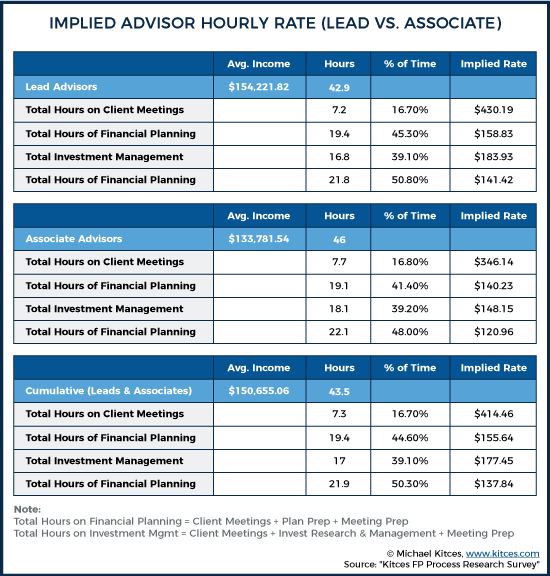
On the other hand, the data does reflect the relative efficiencies that pure investment direction has over financial planning activity alone (or at least, how clients are willing to compensate for those activities). Thus, even though investment-related activities are typically a lower percentage of an advisor's time than fiscal planning activities, the unsaid hourly rate for investment management-related tasks is yet well-nigh xv% college for atomic number 82 advisors managing those investment-versus-financial-planning relationships.
Key Takeaways On How Much A Financial Plan Costs (And What Advisors Charge)
Ultimately, the bottom line is that investment direction alone is increasingly commoditized and pressure grows on financial advisors to deliver more value (i.e., actual comprehensive financial planning!). And from this perspective, it does announced that more and more advisors are get-go to deliver – and accuse separately for – financial planning. In fact, informational firms announced to be in the procedure of bifurcating themselves into those that are predominantly AUM-based, and those that are primarily fee-for-service, with a decreasing number that do a alloy of each.
Still, the market for fiscal plans notwithstanding appears to be relatively inefficient. This is possibly not surprising, given the intangible nature of financial planning itself, and the fact that most clients don't really know what a financial plan is or what they'll probable go out of information technology, at to the lowest degree until after the fact. Thus, fiscal planning fees comport petty apparent relationship to the comprehensiveness of the financial plan itself, or the time information technology takes the advisor to move the client through the unabridged financial planning process.
Instead, value appears (equally e'er) to be in the eye of the beholder, such that the fee clients are willing to pay is most directly related to the client's own affluence (whether measured by income, net worth, or investable assets), and the value that the customer perceives will be received from the plan (relative to their own existing financial situation). Which suggests that advisors are at least able to convey and deliver more perceived value for those more affluent clients (who ostensibly accept more circuitous and high-stakes problems to be solved with financial advice in the get-go identify). Simply at a minimum, it also suggests that at that place are withal many advisors who are trying to deliver a more comprehensive and fourth dimension-intensive service to clients who simply can't afford to pay for that much of the counselor's time and/or the comprehensiveness of the plan… such that time and comprehensiveness itself bears footling relationship to the planning fee. And indirectly, these results as well reverberate the ongoing challenge of financial advisors in explaining the value of financial planning advice in the beginning place (and the greater value of more in-depth and more comprehensive financial plans).
Nonetheless, these results ultimately practise propose that fiscal advisors are able to exist reasonably compensated for their fourth dimension, at least on average, with the typical implied hourly rate of a financial advisor's client-facing fourth dimension generally falling in the $100 to $150/60 minutes range (and adding up to a total income averaging nigh $150,000/year for a lead fiscal advisor). And with advisors only spending approximately 50% of their time on client-facing activities in the first place, arguably the best path to growth for most advisors may not be figuring out how to charge more for their financial plans, but simply how to improve delegate tasks to spend more time on customer-facing activities like financial planning in the offset identify.
The bottom line, though, is just to recognize that the market place has at this point seemed to domicile in on a relatively "standard" fiscal planning fee, of but over $2,000 for a comprehensive financial program… a fee that has changed remarkably niggling over the past 6 years (from only almost $2,200 for a plan under the FPA's original study to $2,400 today). And to the extent that more financial advisors are offering financial planning, fees may, thus far, still exist held downwardly by the fact that most as well accuse AUM fees for investment direction and/or receive commissions for implementation, limiting the need to charge more for a financial plan in the first place. Yet with a divergence emerging between the price of a fiscal plan lonely, and fiscal plans that are "cross-subsidized" by implementation, along with the power of advisors to accuse higher fees when using more than comprehensive fiscal planning software and edifice long-term relationships, at that place arguably is all the same room for financial planning fees to drift higher in the coming years as increasingly commoditized investment management services fade to the groundwork (or at least, split into an increasingly separate service with an independent fee structure of its own).
How To Set Up A Financial Plan,
Source: https://www.kitces.com/blog/average-financial-plan-fee-hourly-retainer-aum-plan-cost/
Posted by: derocheshon1947.blogspot.com




0 Response to "How To Set Up A Financial Plan"
Post a Comment